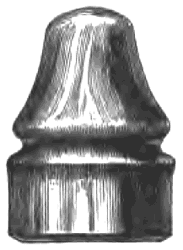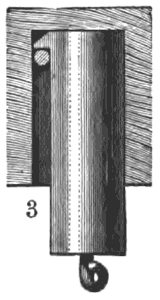[Book]
Publication: A Handbook of the Electro-Magnetic Telegraph
New York, NY, United States
p. 77-80
The Insulators.
The glass insulator, shown in Pig. 24, is the most common form. It is cemented with asphaltum to a bracket which is spiked to the side of the pole, or to a pin which is set in a cross-arm. An improved form of insulator is made to screw upon a thread cut on the bracket or pin, Fig. 25, dispensing with the usual method of fastening with cement. The line wire is fastened to the insulator by a short piece of wire called a tie wire, which is passed around a groove in the insulator and its ends twisted around the line wire on each side. The insulator should never be fastened to the bracket by a spike driven over it into the pole, nor should the edge of the insulator be allowed to touch the top edge of the bracket or the side of the pole, for this forms a connection between the insulator and the pole, causing an escape when the insulator is wet.
 |
 |
Several forms of "suspension insulators" have been used. One of the best of these is Brooks' Patent Paraffine Insulator. (Fig. 26.) The line wire is suspended in a hook set in an insulator of glass, which is encased in a cylindrical shell of iron. The shell is set in a hole bored in the under side of a cross-arm as shown in the figure, or a shank is provided which screws into the side of the pole. Both these forms of insulator are manufactured by Chester, New York.
 |
